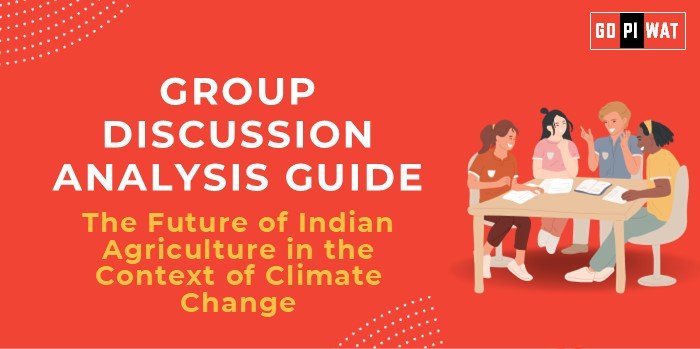📋 The Future of Indian Agriculture in the Context of Climate Change
🌐 Introduction to the Topic
Opening Context: “Indian agriculture, supporting nearly 50% of the population, faces unprecedented challenges due to climate change, threatening its sustainability and productivity.”
Topic Background: Agriculture contributes approximately 18% to India’s GDP and is heavily dependent on monsoons. Recent climatic shifts, including erratic rainfall, extreme weather, and rising temperatures, have disrupted traditional farming patterns and threatened food security.
📊 Quick Facts and Key Statistics
- 🌾 Agriculture GDP Contribution: ~18% of India’s GDP – underscores the sector’s economic significance.
- 💧 Water Usage: 80% of India’s freshwater is utilized in agriculture – highlighting the sector’s dependency on water resources.
- 📉 Climate Impact on Crop Yields: Studies project that climate change could reduce wheat yields in India by 6% to 23% by 2050 and 15% to 25% by 2080.
- 🌍 Emission Contribution: Agriculture contributes approximately 16-17% of India’s greenhouse gas emissions – indicating the sector’s environmental footprint.
- 📑 Crop Insurance Penetration: Approximately 35% of farmers are covered under the Pradhan Mantri Fasal Bima Yojana (PMFBY) – reflecting progress in risk mitigation but also highlighting existing gaps.
🔗 Stakeholders and Their Roles
- 🏛️ Government: Formulates policies, provides subsidies, develops climate-resilient seeds, and promotes sustainable practices.
- 👩🌾 Farmers: Adopt climate-smart techniques and diversify crops to mitigate climate risks.
- 🏢 Private Sector: Invests in technology, research and development, and infrastructure development to support sustainable agriculture.
- 🌍 NGOs & International Bodies: Engage in capacity building, conduct awareness campaigns, and fund sustainable agricultural practices.
✅ Achievements and 🚩 Challenges
✅ Achievements:
- 📜 Policy Initiatives: Implementation of the Pradhan Mantri Kisan Samman Nidhi (PM-KISAN) and crop insurance schemes benefiting over 11 crore farmers.
- 💧 Micro-Irrigation Expansion: Systems covering 80 lakh hectares since 2015.
- 🌱 Research Advancements: Development of drought-resistant crop varieties.
🚩 Challenges:
- ☔ Rainfed Vulnerability: Approximately 68% of the net sown area is rainfed, making it vulnerable to erratic monsoons.
- 📉 Limited Modernization: Low adoption of modern farming techniques among smallholder farmers.
- 📊 Economic Strain: Rising input costs and declining profitability affecting farmers’ livelihoods.
🌏 Global Comparisons and 📚 Case Studies
Global Comparisons:
- 🇳🇱 The Netherlands: Utilizes precision agriculture for sustainable productivity.
- 🌍 Sub-Saharan Africa: Faces heavy dependence on erratic rainfall and low mechanization.
Case Studies:
- 💧 Maharashtra’s Paani Foundation: Promotes watershed management to mitigate droughts.
💬 Structured Arguments for Discussion
- Supporting Stance: “Adopting climate-smart agriculture can ensure food security and economic resilience.”
- Opposing Stance: “Without adequate government support, smallholders lack resources for adaptation.”
- Balanced Perspective: “While climate-smart practices show promise, scaling them requires policy, financial, and infrastructural support.”
💡 Effective Discussion Approaches
- 🧑🌾 Opening Techniques:
- “India’s agriculture supports 50% of its population, but 68% of the land remains rainfed – a critical concern in a changing climate.”
- “Highlight Maharashtra’s success in watershed management through the Paani Foundation.”
- 🔄 Counter-Argument Handling:
- Use data to address objections, e.g., rebut concerns about scalability by citing examples of effective pilot programs.
📌 SWOT Analysis
🌟 Strengths:
- 🌏 Diverse Climate Zones: Allow for varied agricultural practices.
- 👩🌾 Large Workforce: Significant proportion of the population engaged in agriculture.
❌ Weaknesses:
- ☔ Rain Dependency: Over-reliance on monsoons for irrigation.
- 📉 Low Technology Penetration: Limited use of advanced farming methods.
🚀 Opportunities:
- 🌱 Climate-Resilient Farming: Developing and adopting crops that withstand extreme weather.
- 📈 Export Growth: Increasing demand for organic and sustainable produce.
⚠️ Threats:
- 🌪️ Extreme Weather Events: Increasing frequency of droughts, floods, and storms.
- 📉 Global Market Volatility: Fluctuations in commodity prices affecting farmers’ incomes.
📚 Connecting with B-School Applications
- 🛠️ Real-World Applications: Insights into supply chain management, agri-tech startups, and corporate social responsibility (CSR) initiatives.
- 🎓 Sample Interview Questions:
- “How can climate-smart agriculture be scaled sustainably in India?”
- “Discuss the role of technology in mitigating climate risks in farming.”
- 🔍 Insights for Students:
- Understand food supply chains and their resilience to climate risks.
- Explore policy frameworks promoting sustainable agricultural practices.
- Identify entrepreneurial opportunities in agri-tech to support climate adaptation.


